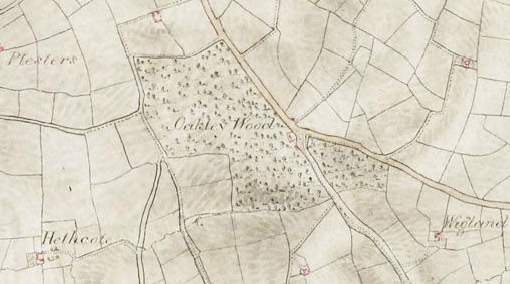Oakley Wood is a Plantation on Ancient Woodland Site (PAWS), which means that although many of the native broadleaved trees were replaced with commercial conifers in the 1950s, the site has been continuously wooded since at least 1600. In fact, there is evidence of the wood dating from the 12 century.
We are grateful to Dr. Sarah Wager for giving us permission to reproduce this fascinating account of the early history of Oakley Wood. This is a short extract from her book Woods, Wolds and Groves: The Woodland of Medieval Warwickshire ((Wager, S.J. (1998) Woods, Wolds and Groves: The Woodland of Medieval Warwickshire.Oxford: J. and E. Hedges)), which is available from the Warwickshire Library Services.
Oakley Wood and Wiggerland Wood
There is an exceptionally early record of Oakley Wood. Richard Peche, who was bishop of Coventry and Lichfield from 1161 to 1182, granted to Bordesley Abbey in Worcestershire part of his wood of Acle (i.e. Oakley) at the road leading to Barford. A road runs from the west side of Oakley Wood to Barford, suggesting that the twelfth-century wood was on approximately the same site as the present wood. This is confirmed by a thirteenth-century deed referring to a furlong in Barford called Pleystowe (whose name survives in the modern Plestowes Farm) whose headland abutted on to the heath towards the wood of Occle to the east and by a later reference to Heathcote (in Wasperton) under Ocle. However, the twelfth-century deed does not say exactly which part of the wood was granted to Bordesley Abbey or whether the wood was at the time more extensive than the area which is presently contained within a great wood bank. The reference to Heathcote under Oakley suggests that it stretched further west to meet the boundary with Wasperton. That area of land between the present wood and the parish boundary was called Church Yard or Heathcote Corner on a map of 1710 but was nowhere near a church.
Evidence suggests that the wood, or part if, had been imparked by 1297-98, when a survey of the manors of the bishop of Coventry and Lichfield referred to a heath next to the park of Okle. References in 1475-6 in the same sentence to both the wood called Oldpark and the wood of Okeley suggest that a single area of woodland had been subdivided into park and wood. It is possible that the latter too was imparked at one stage. In an agreement between the earl of Warwick and Bishop Walter Langton (1296-1321) the earl, in confirming his right to free warren throughout the bishop’s lands in Tachbrook, conceded that the bishop might enclose his wood of Okle and impark it. The great bank which surround the wood has an external ditch, rather than an internal ditch characteristic of a medieval deer park; this suggests that the wood had already been enclosed as a coppice wood.
The southern part of the wood appears to be secondary woodland, because it includes a substantial earthwork of uncertain origin and function. This part of the wood may not have been part of the medieval Oakely Wood. The map of 1710 gives the name Moreton Close to the part of the wood which is opposite Wiggerland Wood and calls the rest Oakley Wood and Moreton Close Wood. Moreton Close was identified as a separate wood in 1609, as was Wiggerland Wood. However, in 1573 a lane called Wyggerlande layne ran between closes, not woods, called Wyggerlande Close and Merton close. It does look as if Moreton Close and Wiggerland Wood developed as secondary woodland in the sixteenth century. There is no medieval record of either.
Only a few of the bishops’ manorial records have survived, but there are records of tenants trespassing in Oakley Wood in 1360, 1364 and 1366 and of sales of wood in 1472-72 and 1475-76.
There are records of relatively rare species of butterflies and moths in Oakley Wood before much of it was replanted with conifers in c. 1956. The southern portion was left as deciduous woodland and the boundary retains some of the Wood’s former springtime glory.


My step father was game keeper to oakley woods aound the late 1930 until it was cut down in the 1950s.It belonged to Ashorne Hill who he was employed by.A that time no one was allowed into the wood,mush to the annoyance of us children.I remember being devistated when they cut it all down and replanted with conifers.the line of trees next to the field of the big house where kept so they could be seen from the main house which was then run by Mr and Mrs Alexander for the British Iron and Steel.
My grandfather was the gamekeeper. His name was Robert Henry Greehnaulgh.
As a child my parents moved to Oakleywood Farmhouse in 1968 and I lived there until 1994.
As a child to me the woods were magical, it was a place where I could take a walk any time of the year.
I now live in Birmingham but I have many photographs of the woods and surrounding areas which I will always treasure.
I was once told that in the centre of the woods there was a roman settlement, but I never did any research into this.